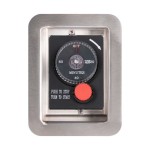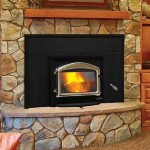Non-Gas Fireplace Options: A Comprehensive Guide
The allure of a fireplace, with its comforting warmth and mesmerizing flames, remains a strong draw for homeowners. Historically, gas-powered fireplaces have been a popular choice due to their convenience. However, growing concerns regarding environmental impact, rising gas prices, and a desire for safer alternatives have fueled the demand for non-gas fireplace options. This article explores various non-gas fireplace choices, outlining their features, benefits, and drawbacks to help individuals make informed decisions.
Electric Fireplaces: Convenience and Versatility
Electric fireplaces offer a clean and convenient alternative to traditional gas or wood-burning fireplaces. They operate by using electricity to generate heat, which is then distributed into the room via a fan or radiant heating. The visual element is typically created by a simulated flame effect, often using LED technology to mimic the look of real flames. These fireplaces are incredibly versatile, available in various styles, including wall-mounted units, inserts, freestanding models, and even entertainment centers with integrated fireplaces.
Installation is typically straightforward, requiring only a standard electrical outlet. This ease of installation makes them suitable for apartments, condominiums, and homes where installing a gas line or venting system would be impractical or expensive. Many electric fireplaces also feature thermostats and timers, allowing for precise temperature control and energy-efficient operation. The heat output can be adjusted or even turned off entirely, allowing users to enjoy the ambiance of the flames without the added warmth, making them suitable for year-round use.
One of the primary advantages of electric fireplaces is their safety. They do not produce real flames, eliminating the risk of carbon monoxide poisoning, sparks, or creosote buildup. This makes them a safer option for homes with children or pets. Furthermore, electric fireplaces require minimal maintenance compared to gas or wood-burning counterparts. There is no need for chimney cleaning, flue inspections, or ash removal.
Despite their benefits, electric fireplaces also have some limitations. The heat output is generally lower compared to gas or wood-burning fireplaces, making them more suitable for smaller to medium-sized rooms. The simulated flame effect, while becoming increasingly realistic, may not fully replicate the aesthetic appeal of a real fire for some consumers. The operational cost depends on electricity prices, which can fluctuate depending on location and usage.
The aesthetic versatility of electric fireplaces is also a significant draw. They can be integrated into various design styles, from modern and minimalist to traditional and rustic. Some models even feature customizable flame colors and brightness levels, allowing users to tailor the fireplace to their personal preferences and home décor.
Ethanol Fireplaces: Sleek Design and Real Flames
Ethanol fireplaces, also known as bioethanol fireplaces, offer a unique blend of modern aesthetics and real flames. They burn denatured ethanol, a renewable fuel source derived from plant matter. This fuel burns cleanly, producing heat, water vapor, and a small amount of carbon dioxide, eliminating the need for a chimney or venting system. Ethanol fireplaces are available in a variety of designs, including freestanding units, wall-mounted options, tabletop models, and inserts.
Unlike electric fireplaces, ethanol fireplaces produce real flames, providing a more authentic fireplace experience. The flames are contained within a burner, which is typically made of stainless steel. The burner can be adjusted to control the flame height and heat output. Ethanol fireplaces are relatively easy to install, requiring no special connections or venting. They can be placed almost anywhere in a room, offering flexibility in design and placement.
Because they burn a renewable fuel, ethanol fireplaces are often considered a more environmentally friendly option compared to gas or wood-burning fireplaces. However, it's important to consider the source and production methods of the ethanol fuel to ensure its sustainability. While they do release carbon dioxide, the amount is generally considered carbon neutral, as the plants used to produce the ethanol absorbed carbon dioxide from the atmosphere during their growth.
The heat output of ethanol fireplaces is typically lower than that of gas or wood-burning fireplaces but can still provide supplemental heat to a room. The flames are visually appealing and create a cozy ambiance. However, it is important to use caution when operating an ethanol fireplace, as the flames are real and can pose a fire hazard if not handled properly. Always follow the manufacturer's instructions for fueling and operating the fireplace.
The cost of ethanol fuel can vary depending on the supplier and location. It is generally more expensive than natural gas, which can be a significant factor to consider when evaluating the long-term operational costs. Proper ventilation is still important when using an ethanol fireplace, even though it doesn't require a chimney. Adequate airflow helps to ensure proper combustion and prevent the buildup of carbon dioxide.
Wood-Burning Fireplaces: A Traditional Option with Considerations
Wood-burning fireplaces represent the most traditional form of fireplace, offering the authentic crackling sound and natural aroma of burning wood. While they require a more involved setup and maintenance compared to electric or ethanol fireplaces, they remain a popular choice for those seeking a classic fireplace experience.
Wood-burning fireplaces require a chimney to vent the smoke and gases produced during combustion. Proper chimney construction and maintenance are crucial for safe operation. Regular chimney cleaning is essential to prevent creosote buildup, which can pose a fire hazard. Flue inspections are also recommended to ensure the chimney is in good working order.
The heat output of wood-burning fireplaces can be substantial, providing significant warmth to a room. However, the heat distribution can be uneven, with areas closer to the fireplace receiving more heat than areas farther away. The efficiency of wood-burning fireplaces can also vary depending on the design and construction of the fireplace, as well as the type of wood used.
Wood-burning fireplaces require a readily available supply of wood. The type of wood used can affect the heat output, burn time, and amount of smoke produced. Seasoned hardwoods, such as oak and maple, are generally preferred for their high heat output and long burn times. Softwoods, such as pine and fir, burn faster and produce more smoke.
There are environmental considerations associated with wood-burning fireplaces. Burning wood releases particulate matter and other pollutants into the air, which can contribute to air pollution. In some areas, regulations may restrict or prohibit the use of wood-burning fireplaces during periods of high air pollution. Choosing an EPA-certified wood stove or fireplace insert can help to reduce emissions.
Maintenance is a significant aspect of owning a wood-burning fireplace. Regular ash removal is necessary to prevent ash buildup, which can reduce the efficiency of the fireplace and pose a fire hazard. The chimney must be cleaned regularly to remove creosote. The fireplace itself may also require occasional repairs or maintenance to ensure its safe and efficient operation.
Despite the challenges, many homeowners appreciate the aesthetic appeal and ambiance of a wood-burning fireplace. The crackling sound of burning wood and the natural aroma create a cozy and inviting atmosphere. Wood-burning fireplaces can also serve as a reliable source of heat during power outages.
Gel Fireplaces: A Less Common Alternative
Gel fireplaces utilize a gel fuel, primarily composed of isopropyl alcohol and a thickener, to produce a real flame. These fireplaces are ventless, similar to ethanol fireplaces, making them easy to install and suitable for various locations within a home. They are typically smaller and more portable than other fireplace types, often used for decorative purposes or as a supplementary heat source in small spaces.
The flame produced by gel fuel is generally less intense than that of wood or gas fireplaces but offers a more authentic appearance than electric simulated flames. Gel fuel typically comes in cans, which are placed directly into the fireplace's burner. Once lit, the gel burns for a specified duration, usually a few hours per can. Replacing the cans is simple, making them user-friendly.
Gel fuel fireplaces are considered relatively clean-burning, producing primarily water vapor and carbon dioxide. However, it's crucial to ensure proper ventilation in the room to prevent carbon dioxide buildup. While they are ventless, adequate airflow helps to maintain a healthy indoor environment.
One of the main drawbacks of gel fireplaces is the limited heat output. They are not designed to heat large areas effectively and are best suited for providing a small amount of supplemental warmth in a confined space. The cost of gel fuel can also add up over time, making them a less economical option for regular heating.
Safety precautions are essential when using gel fireplaces. The cans can get hot during use, so care must be taken when handling them. It is important to keep flammable materials away from the fireplace and never leave a burning gel fireplace unattended. Always follow the manufacturer's instructions for safe operation.
Gel fireplaces offer a simple and convenient way to add a touch of ambiance and warmth to a room. Their portability and ventless design make them a versatile option for those seeking a hassle-free fireplace experience. However, their limited heat output and the ongoing cost of gel fuel should be considered when evaluating their suitability. The aesthetic and the novelty of the gel flame are most of the appeal for these options.
Ultimately, the best non-gas fireplace option depends on individual needs, preferences, and budget. Each type of fireplace offers unique advantages and disadvantages, and careful consideration should be given to factors such as installation requirements, heat output, operational costs, maintenance requirements, and environmental impact. By thoroughly evaluating these factors, individuals can choose the non-gas fireplace that best suits their homes and lifestyles.
:max_bytes(150000):strip_icc()/ventless-gas-fireplaces-4160746-hero-f9d4bdcd9bd446eb84406de306f790ba.jpg?strip=all)
How To Pick Out A Ventless Gas Fireplace

5 Types Of Fireplaces For Apartments Homes Without Chimneys Modern Blaze

Electric Fireplaces A Safe Alternative To Gas Touchstone Home S Inc

No Chimney Problem Blog

Zero Clearance Vs Prefabricated Fireplace Full Service Chimney

What Is A Ventless Gas Fireplace Experts In Gaithersbutg Md

Fires Choices For Homes Without Chimneys Wakefords Fireplaces And Stoves

Ventless Gas Fireplace Propane

A Guide To Choosing The Best Indoor Fireplace Increase Comfort

Fireplaces Smith May Inc








